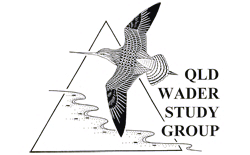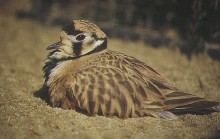Charadrius australis
Subspecies
None
Other Names
Australian Plover, Inland Plover, Desert Plover, Prairie Plover.
Identification
Medium-size rich buff wader with a distinctive Y on it’s front.
Plumage
Adult Plumage: The upperparts are a rich buff that is heavily spotted with black. The white forehead is split from the crown by a black vertical band that joins on the top of the head. The ear coverts are white with a chestnut wash. The chin, throat and breast are white. There is a black band that starts at the white vent crosses the buff belly then splits over the lower breast and flanks to met on the back. The rump is a paler buff. The tail is brown with a pale tip. The short bill is black. The legs light grey
Juvenile: The black of the bandings are indistinct giving a much paler appearance to the bird.
Distribution
Endemic wader of arid Australia, mostly found south of the Tropic of Capricorn. It is found in the south-western corner of Queensland, the western areas of New South Wales, western Victoria, eastern South Australia and western Australia.
Migratory habits
Very little is known of this bird’s movements. It is thought to move seasonally and to follow any rains. It congregates in flocks of some hundreds in the non-breeding season, so there is some movement for this to happen.
Breeding
It has been recorded as breeding from October to February and also in April and May. As other inland species it probably responds to rainfall and can raise two broods if conditions are suitable. The three eggs are laid in shallow scrape, sometimes there is a lining.
Status
It is estimated that there are about 10,000 birds, but estimations are difficult because of the country this bird inhabits.
Confusing Species
None.
Black-fronted Dotterel: Though they both have black markings on the front, these are different, plus this species is half the size.

